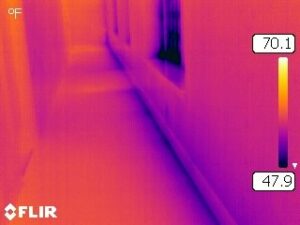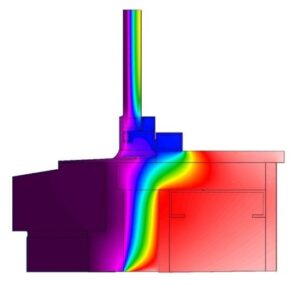
Are you experiencing problems with your exterior walls, such as damp or stained interior finishes or mold? Are the occupants of your building reporting thermal discomfort in occupied spaces adjacent to exterior walls? Are your building’s energy costs unusually high? Any of these issues may be caused in whole or in part by thermal bridging within your exterior walls.
Heat flows through thermally conductive materials such as steel, metals, concrete and, to a lesser extent, wood. The heat flow through conductive materials is known as “thermal bridging”. Under circumstances where significant temperature differences (from exterior face to interior face) develop within exterior walls, a building’s energy efficiency can be notably impacted by thermal bridging, resulting in increased energy costs. Significant “thermal gradients” associated with thermal bridging can also result in water vapor (humidity) condensation on cold surfaces. The effects of condensation within the wall assembly, particularly if the rate of wetting is greater than the rate of drying, can result in the further reduction of the walls’ thermal effectiveness, microbial growth and the premature deterioration of wall components.

Since all building enclosures experience thermal bridging to some degree, managing or reducing the impacts of thermal bridging in exterior wall assemblies should be considered during retrofit applications. Remedial measures to reduce the effects caused by thermal bridging may include the installation of continuous exterior insulation, providing thermal breaks in metal components within the wall, maintaining or improving the rate-of-drying of the wall, and maintaining/improving the wall thermal efficiency.
The installation of exterior continuous insulation with thermally broken girts is an effective method to reduce the impacts of thermal bridging. The addition of thermal breaks incorporated into wall designs, constructed from low thermally-conductive materials such as fiberglass and plastics will reduce the transfer of heat flow, and as such reduce the risk of condensation and mold growth. Evaluation of the causes, effects and appropriate remedial solutions require careful consideration of the existing and proposed wall assembly components by a building enclosure specialist.

To assist in determining the most appropriate methods to improve thermal performance in wall systems, various software programs are available to analyze the affects of adding insulation and/or new cladding systems. WUFI uses a hygrothermal modeling that calculates heat and moisture transfer in multilayered building enclosures. THERM is a program that models two-dimensional heat transfer effects in building components where thermal bridging is a concern.
Thermal bridging should be a constant concern in the design and construction of building retrofits. The effective management of heat flow and drying of wall assemblies will help to mitigate the potential for condensation, deterioration of wall components, mold growth, and improve a building’s overall energy efficiency and thermal comfort of the occupants.
Tagged In:
Building Enclosure Design & Consulting
